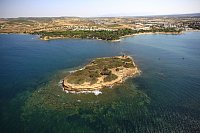Tavşan Adasι
The Bronze Age harbour settlement on the island Tavşan Adası and the later occupation until Byzantine Times – Archaeological investigations north of the ancient harbour of Didyma, West Turkey
funded by the

The small island Tavşan Adası , which means in Turkish “Rabbit Island”, is located north of the ancient port of Didyma on the west coast of Asia Minor. In the Bronze Age, it formed the tip of a headland connected to the mainland. Centrally located in the islands of the Dodecanese, the location with its two natural harbours offered excellent conditions for the establishment of a logistics center within the Minoan Southeast Aegean trade and communication network.
From 2006 to 2014, systematic annual excavations took place within the framework of the Didyma project, led by the German Archaeological Institute. For the first time, the fieldwork on Tavşan Adası and the current analysis of the finds and findings lay the foundation, which contribute to the clarification of the little studied Early, Middle and the initial Late Bronze Age of Ionia and Caria before the so-called Mycenaean impact. The South Aegean cultural and economic orientation of the Turkish Southern Aegean coast is emphasized and at the same time distinguished from Anatolia as well as from the “Troad” further north, whose sphere of influence reaches the Mycale.
The complex causes and innovations, their ways and means of spread, which led to the emergence of the first urban and palatial organizational structures in the South and East Aegean are investigated as well as the way and extent of the flow of goods within the South Aegean network. Archeometric scientific analysis are included in order to define the origin of significant raw materials (copper, lead, tin , obsidian etc.) and finished products (tools, pottery ) as well as to review the reasons for the destruction of the settlement in the late 17th century B. C. A further expected outcome of the project is finally an essential contribution towards the understanding of the character and cause of the so-called “Minoisation” of the South Eastern Aegean in the first half of the 2nd millennium B.C. An early Byzantine chapel, the graves belonging to it, as well as further contexts have been revealed during the excavation. The analysis of these contexts and findings shed light on another period of the settlement on Tavşan Adası.
For more information, please visit the website:
www.minoer.uni-halle.de
Contact:
Prof. Dr. François Bertemes (Principal Investigator)
Tel: +49 (0) 345/5524059
francois.bertemes@praehist.uni-halle.de

Tavşan Adasι
